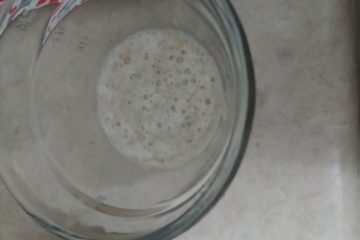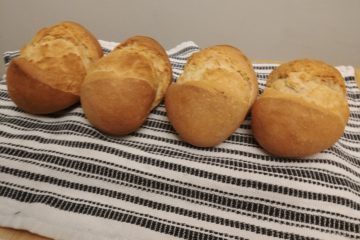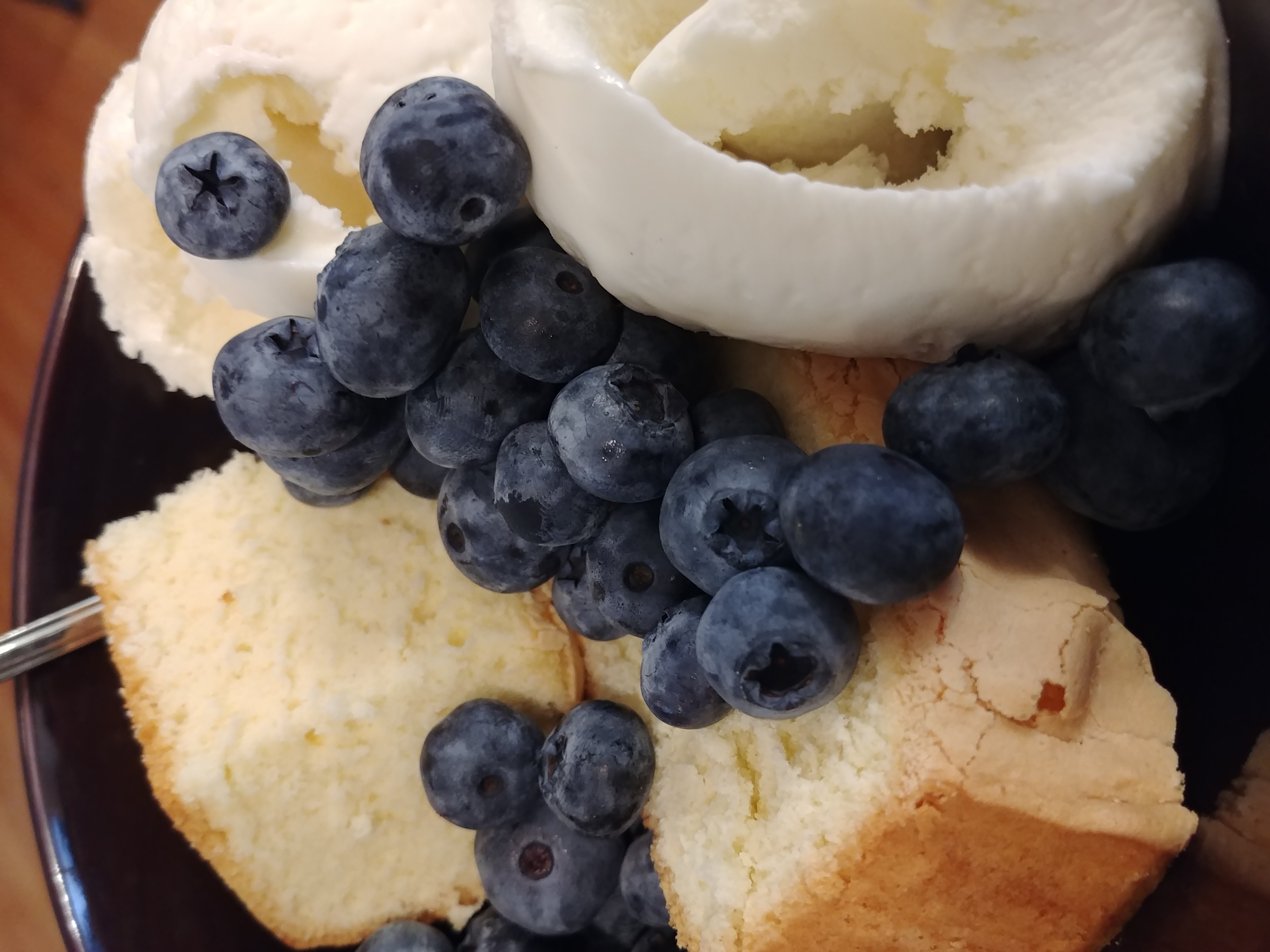4.
5.
6.
7.
8.
In August of 2009 I subjected my friends to my attempts at Cameline sauce (a sort of cinnamon based dipping sauce for meat), and Mustard. I needed more practice with documentation and wrote this up as if it were for a competition.
15th Century Cameline Sauce
This recipe is from “Two Fifteenth Century Cookery-books: About 1430-1450” by Thomas Austin. I first found this recipe as the basis of Daniel Meyers’ Cameline sauce (Meyers). Instead of following his version of this (which was more of an amalgamation of several different Cameline recipes) I followed the given recipe.
Source
Sauce gamelyne. Take faire brede, and kutte it, and take vinegre and wyne, & stepe þe brede therein,
and drawe hit thorgh a streynour with powder of canel, and drawe hit twies or thries til hit be smoth;
and þen take pouder of ginger, Sugur, and pouder of cloues, and cast þerto a litul saffron and let hit be
thik ynogh, and thenne serue hit forthe. (Austin)
My Adaptation
Cameline Sauce
- White bread 1 slice
- Vinegar (red wine vinegar?) 1½ Tbsp
- Red Wine 2Tbsp
- Canel (cinnamon) 1tsp
- Ginger 1tsp
- Sugar 1-3tsp (to taste)
- Cloves ½ tsp
- Saffron small pinch
- Cut the white bread up
- Soak in a combination of wine and vinegar
- Add cinnamon
- Strain it till smooth
- Add ginger, sugar, cloves, and saffron
- Heat if desired
- Mix
- serve
Results
The result was a simple and easy sauce made with ingredients that are easy to find in our modern time.
The result was a sauce that was essentially a cinnamon sauce with very little depth of flavour. The
cinnamon drowned out most of the other flavours, resulting in a very flat sauce. This would be ok for
some meals, but lacks the flavour notes that I was looking for. It was ranked third in the decision of the
tasters.
Two Cameline Sauces from Le Ménagier de Paris
From Le Ménagier de Paris we get two different styles of Cameline sauce. These 1393 recipes seem to
make use of a wider variety of flavours than the later versions. I made both of them to test against
eachother.
Source
CAMELINE. Note that at Tournais, to make cameline, they grind together ginger, cinnamon and saffron
and half a nutmeg: soak in wine, then take out of the mortar; then have white bread crumbs, not
toasted, moistened with cold water and grind in the mortar, soak in wine and strain, then boil it all, and
lastly add red sugar: and this is winter cameline. And in summer they make it the same way, but it is not
boiled.
And in truth, for my taste, the winter sort is good, but the following is much better: grind a little ginger
with lots of cinnamon, then take it out, and have lots of toasted bread or bread-crumbs in vinegar,
ground and strained.
From <http://www.daviddfriedman.com/Medieval/Cookbooks/Menagier/Menagier.html>
My Adaptations
Winter Cameline Sauce
- Ginger 1tsp
- Cinnamon 1tsp
- Saffron small pinch
- Nutmeg 1tsp
- Red Wine 2Tbsp
- Bread crumbs 3Tbsp
- Water (enough to be absorbed by crumbs, not enough to drowned them)
- Red sugar (brown sugar) 1-3tsp
- Grind ginger cinnamon, saffron, nutmeg: soak in wine.
- Moisten bread crumbs in cold water, grind them up into a paste
- Add paste to the sauce
- Strain once
- Boil till smooth
- Add sugar to taste
- Strain again if necessary.
Results
This sauce was easy to make, and had a rich and complex flavour. It was overly thick, and I think that it
should be done with five tablespoons of wine instead of two. The brown sugar lent a nice sweetness to
the dish, while the nutmeg, cinnamon, and ginger gave it a slightly bitter taste. The sauce I made was
also too concentrated, and a better option would be to boil the sauce down if it has too much liquid
rather than risking it having too little. The cooking seems to allow the flavours to blend properly. This
sauce tied for the best of the sauces.
Parisian Cameline Sauce
- Ginger 1 tsp
- Cinnamon 1Tbsp
- Toasted bread 3Tbsp
- Red Wine Vinegar enough to be absorbed by crumbs, and a little more
- Cut bread into squares
- Grind ginger cinnamon
- Add bread and spices to vinegar
- Let soak
- mix/grind
- Strain
Results
Although this sauce was the fastest to make it was the least liked. It was bitter and too harsh, lacking
the subtlety of the other sauces. The addition of brown sugar may have improved it, but because this
version of the sauce was disliked by all tasters I won’t be trying it again.
David Friedman and Elizabeth Cook’s version of Le Ménagier de Paris Cameline Sauce
Source
Note that at Tourney to make cameline they bray ginger, cinnamon and saffron and half a nutmeg
moistened with wine, then take it out of the mortar; then have white bread crumbs, not toasted but
moistened in cold water and brayed in the mortar, moisten them with wine and strain them, then boil
all together and put in brown sugar last of all; and that is winter cameline. And in summer they do the
same but it is not boiled.
Sweet Spicy Sweet & spicy
ginger 1t 1t 1t cinnamon 1t 1t 1t saffron medium pinch for all 3 nutmeg 1 whole 1/2 whl 1/2 whl wine 2T 1/2c 1/2c bread crumbs 3T 2T 2T brown sugar 2T 1t 1T cold water 2c 1c 1c
Grind smoothly until well ground, add bread crumbs, grind smooth, add water and wine, bring it to a
boil, simmer until thickened and add the brown sugar. (Friedman and Cook)
Results
This is the only sauce which I did not adapt as it had already been adapted by Friedman and Cook. I
made the sweet version of this sauce. Though it tied as being liked the most, this was the hardest sauce
to make. The resulting sauce was very thin and required being simmered and stirred for almost two
hours. I also feel that the adaptation is not close enough to the original source. Though this creates a
good tasting sauce, I think that the ratio of liquid to dry ingredients is wrong, and includes vastly more
water than the original recipe calls for.
Mustard by Medieval Cookery
Source
MUSTARD. If you wish to provide for keeping mustard a long time do it at wine-harvest in sweet must.
And some say that the must should be boiled. Item, if you want to make mustard hastily in a village,
grind some mustard-seed in a mortar and soak in vinegar, and strain; and if you want to make it ready
the sooner, put it in a pot in front of the fire. Item, and if you wish to make it properly and at leisure, put
the mustard-seed to soak overnight in good vinegar, then have it ground fine in a mill, and then little by
little moisten it with vinegar: and if you have some spices left over from making jelly, broth, hypocras or
sauces, they may be ground up with it, and then leave it until it is ready.
Le menagier de Paris
Adaptation
Mustard is actually very easy to make. While there were lots of different recipes in the middle ages, this
one is typical, and the final product is perfect for serving with beef, venison, mutton, salted fish, and just
about anything else. Surprisingly, it’s also not very different from modern mustards.
* 4 Tbsp. whole mustard seed
* 4 Tbsp. white wine vinegar
* 2 Tbsp. white wine vinegar
* 1/2 tsp. sugar
* 1/2 tsp. powder douce
Put the mustard seed and 4 Tbsp. vinegar into a small bowl and allow to soak over night.
The next step is to grind the soaked mustard seeds into a paste. As an experiment, I ground some of the
seeds of my test batch with a mortar (which took about 20 minutes) and pestle, and the rest in a food
processor (which took about 2 minutes). As probably cannot be seen in the picture below but was
readily aparent to the naked eye, there was no difference at all in the end results. From now on I will
save the time and effort and just use the food processor.
Finally, mix the mustard paste with the spices, sugar and 2 Tbsp. vinegar. It will taste very sharp initially,
but will mellow out considerably if refrigerated for a couple of days.
http://recipes.medievalcookery.com/mustard.html
Source
[Le Ménagier de Paris, J. Hinson (trans.)]: HIPPOCRAS. To make powdered hippocras, take a quarterounce
of very fine cinnamon, hand-picked by tasting it, an ounce of very fine meche ginger and an ounce
of grains of paradise, a sixth of an ounce of nutmeg and galingale together, and pound it all together.
And when you want to make hippocras, take a good half-ounce or more of this powder and two quarterounces
of sugar, and mix them together, and a quart of wine as measured in Paris. And note that the
powder and the sugar mixed together make “duke’s powder”.
Adaptation
Duke’s Powder
3 Tbsp. ginger
2 Tbsp. sugar
1 1/2 Tbsp. cinnamon
1 tsp. cloves
1 tsp. nutmeg
Note: I did not actually create this version of mustard, as I felt that it was straying too far from the
source recipe.
Mustard from Le Ménagier de Paris
Source
MUSTARD. If you wish to provide for keeping mustard a long time do it at wine-harvest in sweet must.
And some say that the must should be boiled. Item, if you want to make mustard hastily in a village,
grind some mustard-seed in a mortar and soak in vinegar, and strain; and if you want to make it ready
the sooner, put it in a pot in front of the fire. Item, and if you wish to make it properly and at leisure, put
the mustard-seed to soak overnight in good vinegar, then have it ground fine in a mill, and then little by
little moisten it with vinegar: and if you have some spices left over from making jelly, broth, hypocras or
sauces, they may be ground up with it, and then leave it until it is ready.
Adaptation
- Mustard Seed 4Tbsp
- White Wine Vinegar 6Tbsp
- Duke’s Powder (used in hypocras) to taste
- Mix equal parts Mustard seed and White Wine Vinegar
- Allow to soak for at least 8-10 hours, until all vinegar is absorbed
- Grind in mortar/mill/food processor
- Add vinegar till the correct consistency is achieved
- Add Duke’s Powder to taste
- Allow to sit for at least 24 hours
- Sweeten if necessary
Source
HIPPOCRAS. To make powdered hippocras, take a quarter-ounce of very fine cinnamon, hand-picked by
tasting it, an ounce of very fine meche ginger and an ounce of grains of paradise, a sixth of an ounce of
nutmeg and galingale together, and pound it all together. And when you want to make hippocras, take a
good half-ounce or more of this powder and two quarter-ounces of sugar, and mix them together, and a
quart of wine as measured in Paris. And note that the powder and the sugar mixed together make
“duke’s powder”.
Adaptation
Duke’s Powder:
- Ginger 6tsp
- Cinnamon 1½ tsp
- Grains of paradise 6 tsp
- Nutmeg ½ tsp
- Galingale or Cardamom ½ tsp
- Brown Sugar 5 tbsp
If you don’t have Grains of Paradise, omit it and add a few peppercorns and some cardamom (totalling
3tsp), and reduce the amount of sugar by 1 tablespoon. This won’t be as nice, but it should work
similarly.
- Grind ginger, cinnamon, grains of paradise, nutmeg, and galingale or cardamom together
- Mix with sugar
Galingale in this recipe has two potential sources: Cyperus Longus (Galingale, English Galingale) and
Alpinia Officinarum (Galangal, or blue ginger). Both have similar flavours and scents, but English
Galingale is native to the northern Mediterranean region and had spread throughout Europe by the end
of the Renaissance, while Galangal is native to South East Asia (Allen 436). I have come across spices
from the Medieval and Renaissance time period from South East Asia, but it is more likely that it is
referring to the spice which could have been grown in France at the time rather than a rare imported
spice. The flavour of this spice is similar to ginger, but with a hint of cardamom. The advantage of
galingale or galangal is that the flavour does not diminish by drying or grinding. Because of the current
presence of ginger in Duke’s Powder galingale can be replaced directly with cardamom without too
much of an issue.
Grains of Paradise (aframomum (A) melegueta) are much simpler to trace, as it is still available, though
not easy to come by. The spice was very popular in Europe during the Middle Ages as a substitute for
pepper. Originally from the west coast of Africa this spice was used heavily in west and north Africa to
flavour stews and coffees, and was used in Europe to flavour wines and beers (Raghavan 120). Grains
of Paradise have a peppery taste, and are similar to cardamom while being milder than pepper. If you
do not have access to Grains of Paradise a combination of black pepper and cardamom should work as
long as you decrease the amount; grains of paradise are a milder spice than the black pepper/cardamom
blend will be.
Results
his resulted in a mustard that was overly chunky. The next time I make it I will borrow someone’s food
processor for the afternoon, as my mortar and pestle work takes too long. I originally used white sugar,
but it changed the colour of the Duke’s Powder too much, so part way through I switched to brown
sugar. This created a much more consistent spice blend.
Works Cited
Allen, Gary. The Herbalist in the Kitchen. Champaign Il.: University of Illinois Press, 2007.
Austin, Thomas. Two Fifteenth-century Cookery-books: About 1430-1450. Whitefish, MT: Kessinger
Publishing, LLC, 2007.
Friedman, David and Elizabeth Cook. “Sauces.” 1992. Cariadoc’s Miscellany. 18 August 2009
<http://www.pbm.com/~lindahl/cariadoc/sauces.html>.
Meyers, Daniel. Medieval Cookery. 2009. 17 August 2009 <http://www.medievalcookery.com/>.
Raghavan, Susheela. Handbook of Spices, Seasonings, and Flavorings. Boca Raton Fl.: Crc Press Llc, 2006


